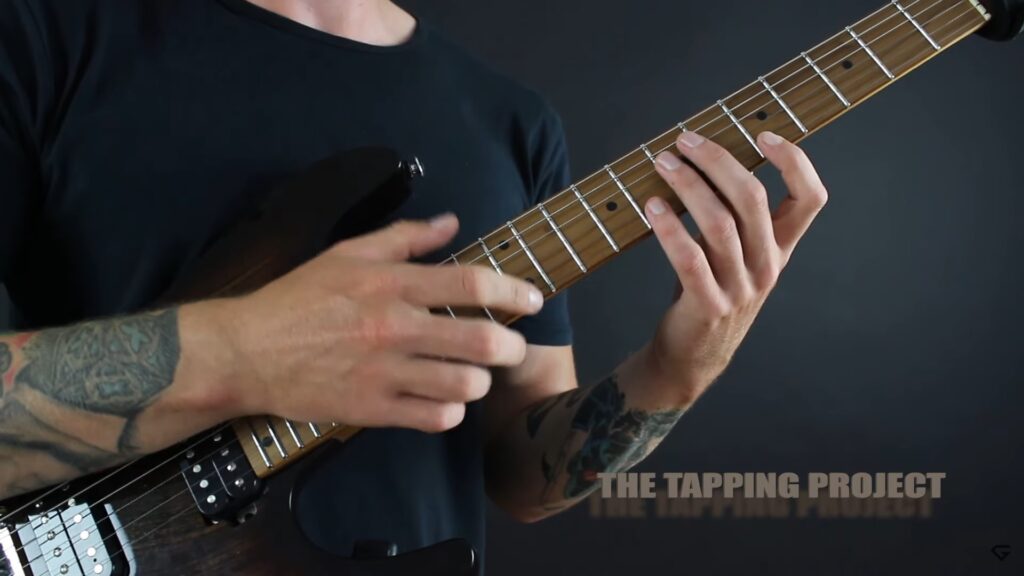Tapping is a guitar technique that has gained popularity for its ability to create fast and intricate passages, allowing guitarists to achieve a unique and impressive sound. Originating in the late 1960s and popularized by guitar virtuosos like Eddie Van Halen and Steve Vai, tapping has become an essential skill for guitar players in various genres, including rock, metal, and fusion. In this comprehensive guide, we will explore the world of tapping, starting from the basics and gradually progressing to advanced techniques.

Understanding the Basics of Tapping
Tapping involves using both hands on the guitar neck to produce notes. The technique primarily relies on the fretting hand to tap notes on the fretboard while the picking hand supports and adds articulation. Start by familiarizing yourself with the basic mechanics of tapping, including hand positioning, thumb placement, and muting techniques. Practice tapping single notes on different strings to develop accuracy and control.
Two-Hand Tapping
Two-hand tapping takes tapping to the next level by incorporating tapping with both the fretting and picking hands simultaneously. This technique allows for greater speed and complexity in your playing. Begin with simple patterns such as tapping a note on the fretboard with your fretting hand while simultaneously plucking a string with your picking hand. Gradually progress to more intricate combinations of notes and string skipping.
Tapping Arpeggios
Arpeggios are an essential aspect of guitar playing, and tapping can add a unique flavor to these melodic sequences. Practice tapping arpeggios across different chord shapes and progressions. Start with basic triads and then explore more complex arpeggio patterns such as seventh chords and extended chords. Focus on maintaining clarity and precision in your tapping technique as you navigate through the arpeggios.
Tapping Scales and Modes
Expand your tapping vocabulary by incorporating scales and modes into your playing. Practice tapping scales such as the pentatonic scale, major scale, and minor scale. Explore various modes like the Dorian, Mixolydian, and Phrygian modes to create different tonalities and moods. Incorporate techniques like slides, hammer-ons, and pull-offs to add expressiveness and fluidity to your tapping lines.
Advanced Tapping Techniques
Once you have a solid foundation in the basics of tapping, it’s time to explore advanced techniques. These techniques include incorporating tapping with other techniques like string bending, vibrato, and harmonics. Experiment with tapping across multiple octaves, creating rapid-fire sequences, and exploring polyrhythmic patterns. Push the boundaries of your creativity and find your unique voice within the realm of tapping.
Tapping Etudes and Licks
To further develop your tapping skills, study and practice tapping etudes and licks. These musical exercises specifically designed for tapping will help you improve your finger coordination, timing, and overall technique. Look for resources online or create your own etudes and licks by transcribing and analyzing tapping passages from guitarists you admire.
Incorporating Tapping in Songwriting
Once you have honed your tapping skills, start incorporating this technique into your songwriting and improvisation. Experiment with adding tapping passages to your compositions, whether it’s in a melodic context or as a dynamic solo section. Use tapping as a tool to express your musical ideas and create captivating guitar parts.
Tapping with Effects
Tapping can be further enhanced by using effects pedals and processors. Experiment with adding delay, reverb, and distortion to your tapping passages to create atmospheric textures or blistering solos. Explore different effects and find the ones that complement your tapping style and add depth to your sound.
Analyzing Tapping Masters
Study the techniques and styles of renowned tapping guitarists to gain inspiration and insights. Analyze the works of guitarists like Eddie Van Halen, Steve Vai, Joe Satriani, and Guthrie Govan. Pay attention to their tapping phrasing, note choices, and overall approach to the technique. Incorporate elements that resonate with your musical vision into your own playing.
Practicing with Backing Tracks
To solidify your tapping skills and develop your improvisation abilities, practice with backing tracks. Use backing tracks in various styles and tempos to simulate real musical situations. Experiment with different scales, modes, and techniques while integrating tapping into your improvisations. This will help you develop the confidence and musicality necessary to incorporate tapping effectively in a band or live performance setting.
Tapping is a versatile and exciting technique that can elevate your guitar playing to new heights. By starting with the basics and gradually exploring advanced techniques, you will gain the skills and knowledge necessary to incorporate tapping into your playing style. Remember to practice regularly, be patient with yourself, and enjoy the process of exploring the vast world of tapping. With dedication and perseverance, you will unlock new possibilities and expressiveness in your guitar playing.